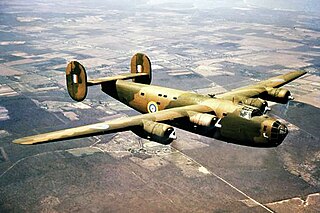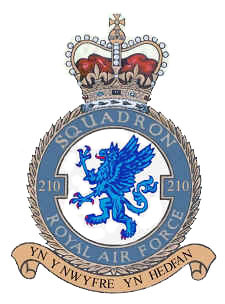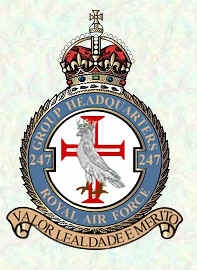
No. 206 Squadron is a Test and Evaluation Squadron of the Royal Air Force. Until 2005 it was employed in the maritime patrol role with the Nimrod MR.2 at RAF Kinloss, Moray. It was announced in December 2004 that 206 Squadron would disband on 1 April 2005, with half of its crews being redistributed to Nos. 120 and 201 Squadrons, also stationed at Kinloss. This was a part of the UK Defence Review called Delivering Security in a Changing World; the Nimrod MR.2 fleet was reduced in number from 21 to 16 as a consequence.

The Vickers Warwick was a British twin-engined bomber aircraft developed and operated during the Second World War that was primarily used in other roles. In line with the naming convention followed by other RAF heavy bombers of the era, it was named after a British city or town, in this case Warwick. The Warwick was the largest British twin-engined aircraft to see use during the Second World War.
German submarine U-219 was a Type XB submarine of Nazi Germany's Kriegsmarine during World War II. The U-boat was laid down on 31 May 1941 at the Germaniawerft yard at Kiel as yard number 625, launched on 6 October 1942, and commissioned on 12 December 1942 under the command of Korvettenkapitän Walter Burghagen.

No. 489 (NZ) Squadron was a torpedo bomber squadron established for service during the Second World War. It was a New Zealand squadron formed under Article XV of the Empire Air Training Plan. Although its flying personnel were largely drawn from the Royal New Zealand Air Force, the squadron served in Europe under the operational and administrative command of the Royal Air Force as part of Coastal Command.

No. 304 Polish Bomber Squadron was a Polish bomber squadron formed in Great Britain as part of an agreement between the Polish Government in Exile and the United Kingdom in 1940. It was one of 15 squadrons of the Polish Air Force in exile that served alongside the Royal Air Force in World War II. It operated under RAF operational command, and flew from airbases in the United Kingdom. It served from April 1941 as a bomber unit in RAF Bomber Command; from May 1942 as an anti-submarine unit in RAF Coastal Command; and from June 1945 as a transport unit in RAF Transport Command.

No. 461 Squadron was a Royal Australian Air Force maritime patrol squadron during World War II which operated under Royal Air Force control flying in Europe and over the Atlantic. The squadron was formed in 1942 and was disbanded in mid-1945, just after the end of the war in Europe. Personnel were drawn from many countries of the British Empire, although the majority were Australians. Throughout the war, the squadron was credited with destroying a total of six German U-boats, and operated mainly in the Bay of Biscay and Atlantic.

Royal Air Force St Eval or RAF St Eval is a former Royal Air Force station for the RAF Coastal Command, southwest of Padstow in Cornwall, England, UK. St Eval's primary role was to provide anti-submarine and anti-shipping patrols off the south west coast. Aircraft from the airfield were also used for photographic reconnaissance missions, meteorological flights, convoy patrols, air-sea rescue missions and protection of the airfield from the Luftwaffe.
No. 61 Squadron was a squadron of the Royal Air Force. It was first formed as a fighter squadron of the British Royal Flying Corps during the First World War. It was reformed in 1937 as a bomber squadron of the Royal Air Force and served in the Second World War and afterwards into the jet age, until disbanded in 1958.

Consolidated Liberator I was the service name of the first Consolidated B-24 Liberator four-engined bombers to see use with the Royal Air Force (RAF).

No. 500 Squadron AAF was a Royal Air Force flying squadron. It was initially formed in 1931 as a Special Reserve squadron and in 1936 became part of the Auxiliary Air Force, at this time based at Manston and Detling.

No. 210 Squadron was a Royal Air Force unit established in the First World War. Disbanded and reformed a number of times in the ensuing years, it operated as a fighter squadron during the First World War and as a maritime patrol squadron during the Spanish Civil War, the Second World War and the Cold War before it was last deactivated in 1971.
No. 233 Squadron RAF was a Royal Air Force squadron that operated from 1918–1919, 1937–1945, 1952–1957 and 1960–1964. The squadron was formed from several Royal Naval Air Service (RNAS) flights and took part in the tail end of the First World War before being disbanded. The squadron was reformed with the advent of World War II. At first No. 233 Squadron flew general reconnaissance patrols before being tasked with transportation duties just prior to D-Day. Shortly after the Second World War the squadron was again disbanded, to be reformed once more in 1960. No. 233 Squadron was finally disbanded in 1964.

No. 502 (Ulster) Squadron was a Royal Auxiliary Air Force squadron that saw service in World War II. It was reformed in September 2013, and is the oldest of all the reserve squadrons, being formed in 1925.
No. 58 Squadron was a squadron of the Royal Air Force. For much of its service history in the First and Second World Wars, it operated as a bomber squadron. In the later stages of the Second World War, it was part of Coastal Command and was engaged in anti-submarine patrols.

Royal Air Force Talbenny, or more simply RAF Talbenny, is a former Royal Air Force station located 5.6 miles (9.0 km) north west of Milford Haven, Pembrokeshire and 7.9 miles (12.7 km) south west of Haverfordwest, Pembrokeshire, Wales.
No. 231 Squadron RAF was a squadron of the Royal Air Force between 1918 and 1946, active in both World War I and World War II in various roles.
No. 248 Squadron was a squadron of the Royal Air Force, active immediately after World War I, and again during World War II.
No. 86 Squadron RAF was a unit of the Royal Air Force during World War II. Attached to Coastal Command the unit flew reconnaissance and air-sea rescue missions, anti-shipping strikes, and anti-submarine patrols.
Coastal Command was a formation within the Royal Air Force (RAF). Founded in 1936, it was to act as the RAF maritime arm, after the Fleet Air Arm became part of the Royal Navy in 1937. Naval aviation was neglected in the inter-war period, 1919–1939, and as a consequence the service did not receive the resources it needed to develop properly or efficiently. This continued until the outbreak of the Second World War, during which it came to prominence. Owing to the Air Ministry's concentration on Fighter Command and Bomber Command, Coastal Command was often referred to as the "Cinderella Service", a phrase first used by the First Lord of the Admiralty at the time A. V. Alexander.

No. 247 Group was formed in October 1943 within RAF Coastal Command to control units operating from the Azores. It disbanded in March 1946.











